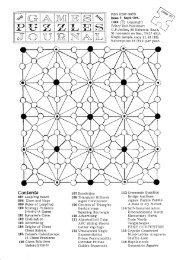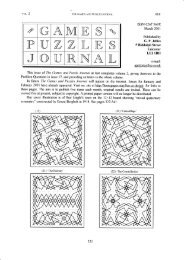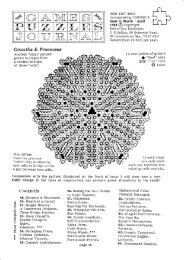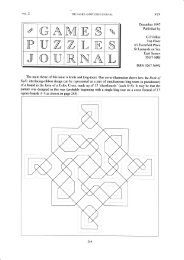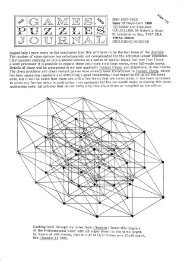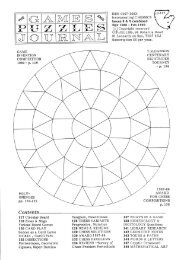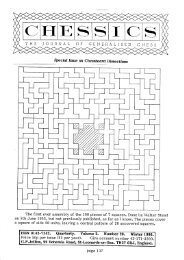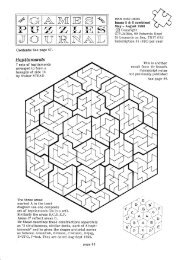The Games and Puzzles Journal, #3 - Mayhematics
The Games and Puzzles Journal, #3 - Mayhematics
The Games and Puzzles Journal, #3 - Mayhematics
- No tags were found...
You also want an ePaper? Increase the reach of your titles
YUMPU automatically turns print PDFs into web optimized ePapers that Google loves.
{r9 G A N/[ E S o+o<br />
z .7 L E g<br />
,r o (J R- F{ A T-<br />
P {_}<br />
-Subscriptionr t5 (US $tO) per year, that is for 6 successive<br />
rssN 0267 -36 9X<br />
Incorporating C HESSICS<br />
Issue 3, January-Febmary<br />
1988 O Copyright<br />
Editor <strong>and</strong> Publisher:<br />
G.P.Jelliss, gg Bohemia Road,<br />
St Leonards on Sea, TNg 6RJ.<br />
Single sample copy f 1 (US $2).<br />
issues starting at any time.<br />
Mothemati.cal<br />
Art<br />
See p48.<br />
O "deadtr cells (sumounded)<br />
o next points of growth<br />
O "live" cells<br />
a<br />
A rrcoraltt<br />
pattern grown<br />
in stages from a<br />
central triangle of<br />
three touching'rcells"<br />
At each<br />
stage new cells<br />
grow, each one touching<br />
exactly two existing cells<br />
that are themselves touching<br />
33. Mathematical art<br />
34. Sapwith<br />
35. Psychological JuJitsu<br />
Blackmarkit<br />
Royal carpet patience<br />
36. Ringing the changes<br />
<strong>The</strong> cross game<br />
<strong>The</strong> ring game<br />
37. Chess problems solutions<br />
38. Parallel time stream chess<br />
39. Caissa's kaleidoscope<br />
40. Sliding block puzzles<br />
Contents<br />
41. Squaring the cube<br />
Circular saws<br />
42. Triangular billiards<br />
43. Cryptarithms<br />
Enum erations<br />
Polyhexes<br />
44. Puzzle questions<br />
Logical grocers<br />
Cross-point<br />
Lunar calendar<br />
45. Exchangeable operations<br />
A singular riddle<br />
page 33<br />
Domino patterns<br />
Multiplication table<br />
Integral part formula<br />
<strong>The</strong> four Rs<br />
Sopwith manoeuvres<br />
46. Cryptic clueing<br />
47. Cryptic crossword<br />
Change chains<br />
Lif ebelt<br />
Solving ladder<br />
48. Stars <strong>and</strong> asterisks<br />
Nlathematical art
^ uotts't<br />
dls"<br />
THE GAMES AND PUZZLES JOURNAL<br />
Sopttttth<br />
Tommy Sopwith, the pioneer aviation engineer, after whom this game is named,<br />
recently attained his 100th birthday, so this article seems appropriately timed. <strong>The</strong> game<br />
is a simple but effective simulation of aerial combat set in the biplane era, <strong>and</strong> is one<br />
of the mainstays of the postal games hobby. Like Diplomacy it has the feature of simultaneous<br />
movement by all the players. <strong>The</strong> board is a large hexagonal honeycomb, representing<br />
an area of countryside, with an airfield in each corner, each with three runways.<br />
In the set as produced commercially (distributed by Quantum <strong>Games</strong> Ltd, 5 Dorking Road,<br />
Tunbridge Wells, Kent, TN1 2LN, copyright Dave Dyer 198) the hexagon has only 9 cells<br />
per side, whereas the postal gamers prefer a more spacious board with 10 cells on each<br />
side, as illustrated. <strong>The</strong> number of cells in a hexagon of side N is 3N(N-1)+1 [cf Chesslgp<br />
11, p8l so that for N=9 there are 2I7 cells <strong>and</strong> for N=10 there are 271.<br />
Firepower<br />
All possible cloud shapes<br />
of 1 to 4 cells are shown<br />
See p 45 for problems on<br />
Sopwith m anoeuvres<br />
<strong>The</strong> moves<br />
-<br />
Each plane begins with 16 units of ammunition, from which up to B bursts may<br />
be fired in each turn of play, when airborne, <strong>and</strong> stocks ean be reptenisneJ uv-r"irr"i";<br />
to home base. Each plane is capable of withst<strong>and</strong>ing 12 units of damage, the degree o<br />
damage inflicted by a burst of fire being 4 units at-close range reducirig to zeroit flu"<br />
cells distance. <strong>The</strong> planes fire only in the three forward directions. twJ units of repairs<br />
can be carried out if the plane is grounded at base for a turn. A number of rclouds'i are<br />
distributed r<strong>and</strong>omly over the board at the start. <strong>The</strong>se are in the shape of various potyhexes<br />
of 1 to 5 cells. In the postal version they may move in the direction of the winb,<br />
as specified by the games master. Damage can result from involvement with these storm<br />
clouds, but they can also be used to hide behind or within. A flyer who achieves a good<br />
score in -inflicting damage points qualifies as an trAcerr who inilicts an extra point of<br />
damage than a normal Aviator thereafter.<br />
One of the most interesting aspects of the play lies in the moves of the planes.<br />
Six. types of move are permitted: Ahead (A), Left Tuin (l,l), Rignt Turn (nf),<br />
(LS), l,ei iiip<br />
Right slip (RS) <strong>and</strong> Immelman (I). only Aces can execute the Immelman reversal.<br />
Each turn consists of three moves (or can be cut short to two or one) <strong>and</strong> up to three<br />
bursts of fire. <strong>The</strong> moves are specified in advance to the games master, or in the o.t.b.<br />
version by t'setting the controls' which are dial-like diagrams provided around the edges<br />
o-f<br />
lne hexagon <strong>and</strong> concealed from the other players by screens until everyone has choJen<br />
their moves. <strong>The</strong> moves <strong>and</strong> firing are then played oui, in three stages, anO tne damages<br />
<strong>and</strong> ammunition used assessed.<br />
page 34
THE GAMES AND PUZZLES JOURNAL<br />
Psycho lo gtc al Jviits'Lr<br />
By Stephen TAYLOR<br />
C
N$"$F<br />
THE GAMES AND PUZZLES JOURNAL<br />
Ringing the Chsrtges<br />
By Vladimir PRIBYLINEC<br />
Two new games are described; for one <strong>and</strong> for two players respectively, each employing<br />
pieces that can be turned over (the white pieces have a black dot on the back <strong>and</strong><br />
the black pieces a white dot) <strong>and</strong> a ring which when placed round a piece effects reversals<br />
or captures (in differing ways in the two games).<br />
Ttre Cross Game is for one player, using an irregular board with a hole, as illustrated.<br />
Initially the board is covered with pieces at r<strong>and</strong>om, some dot-up <strong>and</strong> some dot-down.<br />
One ring is used. Placing it round a piece results in all the pieces in the same rank <strong>and</strong><br />
file (including the piece in the ring) being turned over. <strong>The</strong> obJect is to get rid of all<br />
the spots except one in the ring. Two example moves are illustrated:<br />
o il<br />
i\<br />
€r<br />
t;<br />
o e o o r)<br />
/\<br />
,,/./l<br />
,l<br />
G)<br />
'z"/'<br />
(:) L/ OLC;<br />
o C)<br />
o<br />
(:)<br />
l!.) t,<br />
(-t<br />
@<br />
()<br />
e O<br />
o c o<br />
cia<br />
(:) (o .,f//1<br />
('l i"')<br />
\-/ ( /,//\ () C)<br />
(, o G,llGr o c (j)<br />
c OIC) G;<br />
L/' O<br />
<strong>The</strong> play can be speeded up by noting that (a) application of the ring at two points in<br />
the same rank results in the rank being unaltered while the two files are reversed, except<br />
where they cross the rank, <strong>and</strong> (b) applying the ring at four points at the corners of a<br />
rectangle of ranks <strong>and</strong> files results merely in changing the four ringed points, no others.<br />
<strong>The</strong> Ring Game is for two players, using a 6x6 board. <strong>The</strong> players begin by alternately<br />
placing one piece at a time on the board - each has ten men. <strong>The</strong>y may be placed<br />
either way up. <strong>The</strong>reafter they are moved one piece at a time along a line to a free point.<br />
<strong>The</strong> only restriction is that it is not allowed to have four pieces of the same colgur on<br />
four points forming a small square. On the tr,velfth move the players place their rings<br />
on the board. <strong>The</strong>reafter a move can be by a piece not in the ring, or by the ring itself.<br />
<strong>The</strong> ring can be placed round any piece of your colour provided at least two pieces on<br />
the adlacent (rook-wise) points are the same way up. <strong>The</strong> piece in the ring is unaffected.<br />
Opposing pieces next to the ring are captured. Friendly pieces there are turned over.<br />
Two examole moves are illustrated:<br />
<strong>The</strong> aim is to capture the piece in the opponent's ring, or to leave him with no move.<br />
<strong>The</strong> game can also be drawn by agreement between the players.<br />
Editorrs Note: <strong>The</strong> author is looking for a manufacturer who would like to produce<br />
theseGA-mdames commercially. He has a puzzle called IRIS with t3 coioured dice<br />
currently manufactured in Czechoslovakia. Copyright of the games remains with the<br />
author. Any interested party should write to: Dr Vladimir Pribylinec, Marxova 460'<br />
027 43 Nizna, Czechoslovakia.<br />
page 36
THE GAMES AND PUZZLES JOURNAL<br />
chess prpblems: soltttions <strong>and</strong> comments<br />
Chgssics 126 McDOWELL. E. Albert reports an anticipation. See diagram below.<br />
Chessics 184 SHANKAR RAM. <strong>The</strong> author points out that the Circe Equipollents rules do<br />
not apptv to Kings. This invalidates the set play example I gave.<br />
Chessics 198 SHANKAR RAM. Has a dual 2Kf8'after the key 1Bc3. Correction see below.<br />
Retractors the sides play in opposition, not cooperation the author emphasises.<br />
-Infa'cific<br />
13. MIHALEK. 1Rg6 Ke3 2Re6 RnS* anO IKf 4 Kd4 2Rga Rff Sidelwaysl echo. [R.Brain].<br />
E.Albert reports an anticipation. See diagram below.<br />
14. BOGDANOV & VLADIMIROV. 1Raxb5+ Ka3 2Ra5+ Sa4* <strong>and</strong> 1Rcxb5+ Kc3 2Rcb+ Sc4*<br />
15. vLADIMIRov & OSHEVNEV. 1Bb3 Rc1 2Bd1 c4{ <strong>and</strong> 1eb3 Ra2 zebz a4*<br />
Nos 14 <strong>and</strong> 15 make a good pair. IN.Nettheim].<br />
16. MIHALEK. 1Se7 Kd6 2Se4+ I(e5 3Bf6* <strong>and</strong> 1Bd3 Ke6 2Se4 Kfb 3Scb*trHouse't shape,<br />
quasi-symmetry. [F.wt.M.]. I found this the hardest of the first seven to solve. I didn't<br />
find much of a method for solving it - was reduced to trying many configurations. If<br />
I am right, this makes it more of a puzzle than a togical problem. But am I right tN.N.l<br />
17. GRUBERT. (a) 1Kd4 Kf3 2Rc4 Rg2 3c5 Rd2* (b) 1Qeo+ KfAzKds Rg3 3Sc4 Rd3+<br />
Cooks solving both parts: lKdb Rg7/8 2Qd4+ Kf5 3Qc4 Rd/8+ [A.W.lngleton, <strong>and</strong> others].<br />
18. GRUBERT. 1...Itc3 2Rf5 Kd2 3Kd4 Bd6 4Rd5 c3* anO 1...c4+ Kc5 Kc3 3Rf6 Bc 4rc6 d4*<br />
Cooks: IKa/bZ Kd4 2Kb/e1 Kc3 3Bg3 Rd4 aBel* [t.G.poltard <strong>and</strong> others].<br />
19. McDOWELL. 1-4Pf1=R Pa8=R 5Rfb Ra4* Copycat! [T.G.P.J Sly R-promotions insitu!<br />
tA.W.I.l Cute double R promotions IN.N.I R. Prom + Ruckkehr doubled [D.Nixon]<br />
Astonishingly the only way! [R.8.]<br />
2A. MIHALEK. 1Gg3 Ke4 Zgh} Se3 3Rf4+ Overshadowed<br />
2L. GRUBERT. lReb+ Kf4 zRdb Bb4 3Kd4 Seb* Duplex:<br />
Each pleasihs, together quite remarkable! [R.8.]<br />
22, MIHALEK. 1Be3 Ge2 2Kd4 Kdo 3Gd3 pfxe3*<br />
23. MIHALEK. 1Gg8 Ke5 2Re+ Kdo 3Gf Z Sd aRe6*<br />
Cook: 1Gg4 Ke4 2Kb3 Ke3 3Kc2 Se4 4Rf 3+ [R.8.]<br />
24. MIHALEK. 1Rf2 Gf 3 ZF"gZ Gg4 3Rg3 Gh3 4Rf3 Ge2*<br />
,<br />
by No.23. IA.!V.I.] Ideal rnate.<br />
1Gc6 Ke3 2Sf6 Rg7 3Ge6 Rgs*<br />
%o"^\J,,A<br />
For solving ladder see page 4T ,<br />
To allow more time for solving<br />
solutions wilt in future appear<br />
in the second issue following.<br />
Cooks: 1Rg3 Ggl 2Rg2 Gg/h3 3Rf2/93 Gc/g4 4Rf3 Ge2* [T.c.p. <strong>and</strong> R.B.]<br />
25. MIHALEK. 1Rb6 Sb 2GaT Kdb 3Gc Scb anAO* A nice one. [D.N.]<br />
26. MIHALEK. (a) 1Kb5 Gc6 2Kb6 Rb1+ 3Ka Gd5 4Ka8 Rb* (b) 1Rf8 ZRf4 BGe4 4Rg4<br />
5Gf3 6Rg2{ tmaginative pairing. tR.B.l<br />
27. JELLTSS. (a) 1Ge5 Gf1 2Ge1 Gf5 3Ge3 Gf3* (b) 1cd2 Gg4 2Gg5 Gd1 3Ge3 Gf3f<br />
Severe move restrictions. [D.N.] Deux pas de deux. IR.B.I.<br />
28. JELLISS. (a) LRd6+ Kc 2Rd5 Gc4 3Rb5 Kc8 4Ga5 Ga6* No one found this. <strong>The</strong> trv<br />
1Rc2 Gc(iltegat self-check) 2cb1 Gc1 3Ra2 Kc8 4Ra1 Gxal* (or 3Rh2 etc 4Rhl eic).<br />
was too tempting. (b) 1Re6+ Kc8 2Gd7 Gd5 3Re8+ Gd8 4Rxd8+ Kc* but Cooks;<br />
1Rc4 Gf4 2Gc8 Gb4 3Rc+ Kd6 4Rb cUe* tA.w.I.l or 1Rb6 Gf4 2Gc8 Kd8 BGe8 Kc<br />
4Rb5 Gb8+ [G.P.J.] New <strong>and</strong> attractive fairy type. tD.N.l <strong>The</strong> idea of twinning by this<br />
method was in fact suggested to me by W.H.Reilly.during the FCCC days. Seniitive<br />
Kings first appeared in France under the name of tRoi Bicolord". Re-seiting below.<br />
126(A) Helmer TERNBLAD lgS(C) N.SHANKAR RAM<br />
Fegnschac-h 1955<br />
Mate in -2+1 in 4 ways<br />
hm 2 (with set)<br />
pacif ic Retractor<br />
%%%%<br />
%,9%, ;w '%<br />
%,A%,<br />
%%%%e<br />
'%,f%%D%;%<br />
/:ffi.<br />
'ffit/%A%, '%'n%'%<br />
13(A) P.A.P[iTIiO!V<br />
5145 Arbe lder-Skak<br />
hm2 two wavs)<br />
28rc) G.P.JELLISS<br />
1 961<br />
hm 3 (b) sensitive Kings<br />
1...8c6 2Sb4 SdZ+<br />
1tlb4 Sc3 2Sc5 BdS+<br />
Keys 1Gc3/Gc5 /Bd6/Bh6<br />
with the same moves on the<br />
2nd move also, foll. by Bf b*<br />
page 37<br />
Rf4 Kc8 2Rb4 Ga3+ 3Ga5 Ga6*<br />
Gd7+ Keg 2Rfg+ Gdg 3Rxd8+ Kc*
fd<br />
THE GAMES AND PUZZLES JOURNAL<br />
P orv,llel Ttme - Str e om Che&s<br />
By C.M.B.TYLOR<br />
"sF' This is an application to Chess of the science fiction idea of parallel universes.<br />
A player,, before making his move, must first switch to a 'parallel time-stream, by changing<br />
one of his earlier moves. <strong>The</strong> rest of the moves in the game are then played, accorling<br />
to exactly defined rules, to follow as closely as possible those in the original 'timestreamr;<br />
the player then makes a normal move. (It is possible that the changes may result<br />
in the game ending in mate without this extra move being played.)<br />
<strong>The</strong> rule for a tparallel' move is that the pieee moved is the one geometrically closest<br />
to the starting square of the original piece, <strong>and</strong> it is moved to the square geometrically<br />
closest to the original finishing square. If in either ease there is more than one possibility,<br />
the piece furthest back is moved to the square furthest forward; if there is still<br />
more than one possibility, the piece furthest from the centre is moved to the square<br />
nearest to the centre. Thus if White has played 1Pd4, 2Pe4 <strong>and</strong> 3Qh5, <strong>and</strong> changes his<br />
second move to Qd3, his third move will (assuming that Black's moves do not interfere)<br />
become Bh6. This is because c1 <strong>and</strong> el are equally close to the starting square d1, <strong>and</strong><br />
also equally far back, but cl is further from the centre; g5 <strong>and</strong> h6 are equatly close to<br />
the finishing square h5, but h6 (although further from the centre) is further forward.<br />
<strong>The</strong> change to 2Qd2 would lead to 3Kd1. Castling is taken as a King move; promotion<br />
is to the piece that the player had moved most recently (or, if only the King <strong>and</strong> Pawns<br />
had moved, to a Queen).<br />
As a possible game, White opens 1Pa3 <strong>and</strong> Black replies ...Pa6. <strong>The</strong>se opening moves<br />
do not really matter, as they must both be changed next time; in practice the game could<br />
be started at move 2. White changes 1Pa3 to Pe3, <strong>and</strong> plays 2Qh5. Black similarly changes<br />
L...Pa6 to ...Pe5 <strong>and</strong> plays 2...Qf6. <strong>The</strong> best opening strategy I can think of is to go all<br />
out for Scholar's Mate! White changes 1Pe3 to Pe4, which does not affeet the rest of<br />
the moves already made (...peS 2Qh5 Qf6) <strong>and</strong> plays 3Qxf+. This is not really a sacrifice,<br />
as pieces captured need not stay captured.<br />
Things now get interesting, <strong>and</strong> there are at least three traps that Black can fall<br />
into. (a) If Black changes 1...Pe5 to Pe6 <strong>and</strong> plays 3...Kxf, White can change 3Qxf+<br />
into Qc5. Black's third move now becomes ...Kd8, <strong>and</strong> White can play 4Qxf8 mate. (b)<br />
If Black changes 2...Qf3 to Sf3, <strong>and</strong> again ptays 3...Kxf, White can change 3Qxf+ into<br />
QgS, <strong>and</strong> now after 3...Ke7 play 4Qxeb mate. (c) tf Black changes 2...Qf3 to Sh3, <strong>and</strong><br />
plays 3...Sxh, White can change 3Qxf7 into Bc4, <strong>and</strong> now after 3...Sg8 play 4Qxf7 mate.<br />
Since a player needs to review the whole game before deciding on a change <strong>and</strong><br />
a move, this chess variant is probably better played by correspondence than over the<br />
board. Four correspondence games between myself <strong>and</strong> R.M.W.Musson all lasted less<br />
than ten moves; in one, Black mated on move 6 after a mistake by White on move !<br />
As these games progressed, it emerged that it was actually possible to plan ahead to<br />
some extent' making a particular move because of the possible effects of changing it<br />
in a later parallel game.<br />
Problem: What does White do after 1Pe4 PbO 2Bc4 Bb7 3Qf3 PeG 4Sc3 Pf 5<br />
Carsscts Kaleidoscope<br />
Notes on the orrg.inal_problems.30 <strong>and</strong> 3l were sent by <strong>The</strong>odor Steudel, describing<br />
tnemd'half-home-base'probiems,bymyfriendtheCoun1<br />
of Whitefield, who is Iiving most of his time in my Bavarian home. (Nevertheless by the<br />
way he shouts twice a day 'I remain British ...!') "<br />
Serieshelpstalemate (Shp) see issue L. Grasshopper (42 <strong>and</strong> 43) <strong>and</strong> Helpmate (hm)<br />
see issue 2. Prciblems 29 <strong>and</strong> 4l are Direct mates. fne boarO in 41 can Ue any size you<br />
like! N is the number of squares along a side of the board. Problems Bg <strong>and</strong> 40 are Direct<br />
stalemates. In Reflex mates (30) White moves first <strong>and</strong> tries to force Black to checkmate.<br />
Either player must mate on the move if able. <strong>The</strong> Moose c2 in 47 can hop to the squares<br />
a5'b6rc6,d4,e3, over the three hurdles. <strong>The</strong> Eagle has a similar choice of two destination<br />
sguares - the squares to right or left of the hurdle. <strong>The</strong> twinning in 38 is: (a) as diagram,<br />
(b)e1-d4, (c)e1-g3, (d)ds-d3, (e)uz-ul, (f)b-b6, (g)uz-ez, (n)uz-cz, (i)b-f6.<br />
Further problems are invited - particularly Circe compositions <strong>and</strong> Leapers.<br />
page 38
41, Peter WONG<br />
Mate in N-2<br />
\'%A%<br />
7' 'ry,<br />
%, /&<br />
/4, %,<br />
ry'ruj<br />
%4)<br />
v,'%l<br />
45. G.P.JELLISS<br />
hm 2+ (Z ways) Moose<br />
f'<br />
"bn<br />
THE GAMES AND PUZZLES JOURNAL<br />
\.,<br />
An<br />
'oB, -C48<br />
30. dc'31. <strong>The</strong> Cou of ^<br />
WHIT EFIELD 32, I.SHANAHAN<br />
Reflex mate in 5 Shp I<br />
Shp 19 "Sword & Shield'f<br />
'% ...7r.'%,w<br />
%,'%<br />
'%.<br />
%g%<br />
%, %t \GL',%',%%l '% '%;'%r&.,ftE<br />
%, %t% '%<br />
'%'%ie% t%%%%l % % %,t%<br />
% /%, l:trz %,<br />
'%<br />
%, '%, %,%%/,ft<br />
I<br />
'%<br />
'/z | ry, % '%,t'ul<br />
'%, % %, |% '%<br />
%%%t%<br />
%,t^<br />
frifu, %,fi% '%<br />
, i '%ft%, ,e w '%, %<br />
'% eww% W<br />
I<br />
^i<br />
'n/ew'%l<br />
/,ft,<br />
%t%8ry,1<br />
34. S.J.G.TAYLOR 35. S.J.G.TAYLOR<br />
HOLLADAY<br />
hm 2 (two ways) hm 2 (two ways)<br />
(two ways)Ȳ%<br />
'%,%%% %,%%%<br />
| %,,%" %. %)<br />
\ru,%%'u, l%,t% %,<br />
%H,% % l%%%%)<br />
1<br />
%,<br />
%<br />
l%%%%;<br />
%,'%A',% % \ru, '%D'D- %<br />
%&,fr%, I ',% %,9'/, %<br />
%g'%,<br />
I<br />
%<br />
'n)<br />
|%i6ft% '%<br />
%%%,%<br />
i*%'%Tffi,<br />
| ;%, ,,&fr'n %,a'% %<br />
i.,,,,.%.,,<br />
I<br />
1<br />
%<br />
7zl<br />
,.,r%)),<br />
lt%i,-ffi--%-%)<br />
T<br />
&",fua%,<br />
w% l%,% , %, %, %<br />
'/2, ',n<br />
r<br />
38. F.M.MIHALEK 39. E.HOLLADAY 40). E. HC :OLLADA]<br />
ADAY<br />
hp3 (a) p3 (b) 90o right p4 p4I t(b)c<br />
d4 t4 -b4<br />
4<br />
'/2, %, %, %, %l %, '%'n-ry, ;--<br />
t1rc'tN'l'<br />
&% T%<br />
%<br />
'tN'l'.<br />
"%,<br />
uT TZ %,<br />
,lf<br />
',%,<br />
%, '%, '% '%, q\<br />
l:w, ,h%<br />
%%<br />
%<br />
m%,<br />
% '%i,t<br />
fl,Afrfr'& %<br />
It %,9 %,i e% %'% i<br />
%, '%,&% . %w% '% %,<br />
%%<br />
'%,<br />
% %,a:%a%,'h<br />
,,<br />
%,<br />
%'%<br />
t'rffi,<br />
%,. ,<br />
,,ffi,<br />
'fu,,<br />
i t<br />
%:&%, '%,,<br />
%<br />
a/,ffi<br />
%<br />
%/,fu%%, '%:g% %, '%, i'ma<br />
'm4<br />
,%,<br />
%%'%'%,<br />
,% %%%<br />
% trzl<br />
%'%, %, %<br />
% 7<br />
% %<br />
i% %t%<br />
,%r,.'<br />
7///,<br />
%_%%%<br />
% %%%<br />
42. C.VAUGHAN 43.A.!V.INGLETON<br />
hm3 (how many ways) hm 4(2 ways) No W K<br />
%, %,,<br />
%<br />
%,<br />
'%, %'%<br />
%H% %<br />
%, %Hr,fr %<br />
'mg<br />
'%,, 'ffi, '%,.<br />
'%%<br />
7t 7/, ',%,<br />
,%r.<br />
e%,<br />
%,<br />
//, ',/,/./,/.<br />
'n%%'%<br />
'*ft%,%D%w%'<br />
....,%. %.'%:m<br />
'%%%'ffi;K**<br />
,3<br />
4'T. G.P.JELLISS<br />
hm3 Moose, (b)c5=B<br />
,v'<br />
7/, "%. '/' ',%l<br />
',/./,/,/ ',/,/,/,/ './ /./ ,/ I<br />
|%, % '%, %, i<br />
1.,,,,%r.,* %l<br />
l:,%,<br />
^ ,% '%,<br />
i<br />
,9//i .,..'71r ,, ./fr,.,., ,7/::1<br />
i:iiiz 77;&117, 7z I<br />
1,,,,"%E'h''.,<br />
(,2--%--%,-%-:<br />
Solutions to reach me by Lst May<br />
page 39<br />
44. G. P. JE L LISS<br />
hm 2 Eagle hm 2 *<br />
I U W, %;V'ru<br />
l:ffi, %t, % %,<br />
lg;w'%%<br />
lMt%%,%<br />
r%,H%'%. %91<br />
lw%'%.,E'1<br />
l:%@%i % %<br />
48. G.P.JELLISS<br />
Mate in 3, Moose<br />
i:Lh.2 6 A<br />
i:ab -2 m<br />
ilk'%W%<br />
'D<br />
I:a ! 22 '%- %<br />
iogl ,r%'""ru""''%,<br />
7(Ei'*%07A<br />
%'%%,%
.N\5<br />
n+"'<br />
ns$'\o'<br />
Problem<br />
From<br />
Solution<br />
a<br />
V1<br />
ln<br />
a<br />
THE GAMES AND PUZZLES JOURNAL<br />
Sliding Block <strong>Puzzles</strong><br />
three loops of lengths 6,6,4 or<br />
or<br />
0r<br />
416,6<br />
0r<br />
giving 1O<br />
l*3<br />
13 1l<br />
lro<br />
12 1 5l<br />
moves in all, 4 ways:<br />
to<br />
Problem 4z A<br />
this is probably<br />
solution in<br />
much longer<br />
35 moves is: 34,58 5,4657 84,65846,531265,g3g ,265472r4 but<br />
than necessary. It transforms<br />
Problem 5: Held over pending further work (i.e. I haven't solved it yet!).<br />
iTr3lE;:vil-:iirf,|,s28rsln2341<br />
l5 6 7 sll8t3 zrrl ls 6 7 sllgr+ q sl ls 6 t al<br />
le10111zll10 316 5l lsrorrrzllo rrrrzl lgrorrrzl<br />
113 14 15 161 lrs 0= g +l lrs rs r+ ol [o rs z ol lrr r+ rs ol<br />
A A, B ----Br- T<br />
to<br />
No solution to Sam Loyd's magic square problem, mentioned last time, was given<br />
in Tit-Bits at the time, but Robert B.Ely III (ref 4) states that the magic square ,.i.n.o<br />
in ffimoves from the normal array A by removing 16 <strong>and</strong> replacing it after the<br />
moves is Ar, but he d-oes not say how many moves. Loyd gave tne prouem of transforming<br />
B, the 14-15 Puzzle start, to a magic square, the biani countini zero, in 190g (ref<br />
He gave s).<br />
a solution in 50 moves, but Sliding.-Piege <strong>Puzzles</strong> gives onJ to B' in only 36. <strong>The</strong><br />
similarproblemstartingfromCisffiy(rerol-*itnasolutionin3<br />
moves' which has since been improved to 3-5 to position Ct. Edward Hordern<br />
a letter<br />
writes in<br />
that these improved results were found by Len Gordon of chico, California,<br />
with the aid of a computer.<br />
References (continued): (4) <strong>Journal</strong> of Recreational<br />
No t, p4. (5) Our Puzzle Magazin<br />
LgL7, problem 40L<br />
1 10 15 4<br />
13 6 3 B<br />
2 912 7<br />
L4 5 0 11<br />
c'<br />
Mathematics, January 1908, Vol 1,<br />
ati cs,<br />
-7<br />
5 9<br />
E<br />
1<br />
5<br />
G g %<br />
3 I<br />
3 I<br />
Problem 6: Get My Goat. T.W.MARLOW writes:r<strong>The</strong> excellent book Slidins piece puzzles<br />
byL.E.Hordernincludesthe'lGetMyGoat''puzzIediagrammeoauffi<br />
the book, <strong>and</strong> dates back to 1914, when it was patented by J.I.Wileyl. This calls formoving<br />
the goat' G, inside the fence, by using the empty space to slide the pieces. It solves in<br />
28 moves as follows: 56756 43296 296c1 69542 b2bc 961.<br />
Hordern refers to the apparent impossibility <strong>and</strong> the simple unexpected solution.<br />
This of course relates to the fact that pieces 2 <strong>and</strong> 6 become intercnanged in the solution.<br />
However, the form of words caused me to look for a solution even more unexpected.<br />
As a consequence I managed to solve in 24 moves in a way which I think is still within<br />
the requirements of the wording of the puzzle. Can you find this solution"<br />
page 40
THE GAMES AND PUZZLES JOURNAL<br />
olssec|orfs<br />
Sguaring the CuM<br />
Of course, it is simple to cut a cube into N2 layers of equal thickness <strong>and</strong> arrange<br />
them to form an NxN square array - but the result is not reallv a square, but a prism<br />
on a square base. Anyway, we could take N=1r since the cube is a square prism already.<br />
<strong>The</strong> riddle is answered by using a hollow cube, cutting it along sufficient edges<br />
to allow it to be folded flat, <strong>and</strong> then transforming the shape thus obtained into a square.<br />
<strong>The</strong>re are 11 ways of flattening a cube [Stephen Ainley, Mathematical <strong>Puzzles</strong>, L977,<br />
p65r as rorrows:<br />
[-, kf qr q1 +q tr i] TL' Il {t +<br />
1I U IJ IJ iJ U U IJ LI U IJ<br />
LJ<br />
<strong>The</strong> f irst<br />
known methods<br />
of these shapes is easily transformed to a square in four pieces, bV well-<br />
196 3l as illustrated:<br />
[e.g. Harry Lindgren, Geometric Dissections<br />
Ctrcular Sows<br />
A single semi-circular cut can be used to divide a iircle<br />
into tio differently shaped parts (a crescent <strong>and</strong> a "digon")<br />
as illustrated. If the circle is of radius r thel the area of<br />
P ine oigon is: r2[o - cos 0 sing + *n(sing )2], where -o' is<br />
in radians (Oegrles times n/1S0). In this formula o 12 is<br />
the area of tlie sector OAPB,(r cos O) (r sin g)is the area<br />
of the triangle oAB (so that their didference is the area<br />
of the segment APB) <strong>and</strong> *n (r sin e )2 is the area of the<br />
semicircle AQB.<br />
By selecting appropriate values for 0 the area of the digon can be made a simple fraction<br />
of that of the circle, as in the following Table <strong>and</strong> Figures.<br />
Table of values of e to give digon area as simple fraction of circle area'<br />
31.218+ means the value lies between 31.21"8 <strong>and</strong> 31.219. Values found by<br />
step by step approximation, using a 'scientifict calculator'<br />
area: I/6 I/5 I/4 t/3 2/5 I/2<br />
e: 31.218+ 34.200+ 38.298+ 44.472+ 49.039+ 55.541+<br />
area: 3/5 2/S 3/4 4/5 5/6<br />
e: 61.655+ 66.062+ 7L.427+ 74.756+ 77.043+<br />
<strong>The</strong> diagrams are only intended as a guide <strong>and</strong> are not very precisely drawn.<br />
Dissections continued on<br />
page 4L<br />
p4 3.
,(s<br />
"cy<br />
Problem 3,<br />
a pocket so<br />
factorily by<br />
THE GAMES AND PVZZLES JOURNAL<br />
Trtarryulcr BillianJs<br />
the question of what happens when a ball is cued direcily into a corner without<br />
as to hit both side-s of the angle simultaneously has now been answered satis-<br />
Professor A.G.MACKIE, who summarises his ma]n results as follows:<br />
rr<strong>The</strong> notation in the diagram is self-explanatory.<br />
We assume 0<br />
rl, = 0 as is well known. But more generallv we<br />
can show that U=0 when 0= 2tan-1(11-1) for<br />
m = 1r3e5e... i.e. for 0 = 90o, 36.87r, ZZ.620r..o<br />
In addition rf = 0 0 when O= 2tan-1(r-L; for<br />
m = 2r4r.o. i.e. for Q= 53.13o r 28.0o, ....<br />
"<strong>The</strong> theory assumes flexible cushions <strong>and</strong> linear restoring forces proportional to<br />
the magnitude of the indentation on a given cushion <strong>and</strong> perpendicular to that cushion.<br />
<strong>The</strong> centre of the ball then acts like a particle subject either to two restoring forces<br />
at an angle 0 to each other, or to Just one such force, for the periods during which both<br />
cushions, or Just one eushion, are respectively indented. <strong>The</strong> results I have quoted correspond<br />
to the rather special eases when two forces act until the centre of the ball is<br />
again at O after which no forces act. <strong>The</strong>se apply for the given values of q <strong>and</strong> for all<br />
0 in 0 S 0 S S. <strong>The</strong>re is another more obvious special case of this which hotds for any<br />
0 but only when 0= i/2. For all other cases there is a period when two forces act followed<br />
by a period when Just one force acts. I have a computer program with graphics<br />
which can cope with any case.<br />
ItAlthough the analysis is reasonably straightforward, it is really quite interesting<br />
<strong>and</strong> I am grateful to you for bringing it to my attention.'r<br />
Fuller details will probably appear in a more technical <strong>Journal</strong>.<br />
Problem 4. If a ball is proJected into a corner of angle V at an angle U (
THE GAMES AND pTJzzLEs JouRNAL<br />
Cryptarithms<br />
to,u<br />
'7&n a2<br />
<strong>The</strong>se are the solutions to the T.H.WILLCOCKS cryptarithms in the last issue.<br />
(4) RACHEL x2= ALIS0N (5) ALISON x2= RACHEL (6) ALIS0N x3= RACHEL<br />
378145 x2=756290 365148 xz=130296 243168 x 3 = 7zgs04<br />
I hope these haven't caused two much trouble between (the real-tife) Alison <strong>and</strong> Rachel!<br />
(7)' Stephen TAYLOR offers the following cryptarithm, which he says is "Just one of<br />
those things which get h<strong>and</strong>ed down through the family!t Can anyone identify a source<br />
for it Some similar problems, but with only three terms in the addition, ar-e given in<br />
Madachyts Mathematical Recreations (Dover 1979, originally published as Mathematics<br />
on<br />
atical Diversions"'(Van"Nbstr<strong>and</strong> f g6i,f<br />
byJ.A.H.Hunter<strong>and</strong>J.S.Maoac@stheseauthorsgivealsorequire<br />
certain extraneous conditions to be satisfied (e.g. that THREE be divisiUte Uy 3, or that<br />
NINE be a perfect square). <strong>The</strong> only unconditional examples they give are (g) <strong>and</strong> (g):<br />
(7). ELEVEN+THREE+THREE+ONE+ONE+ONE = TWENTY -<br />
(8). ONN+IWO+FIVE = EIGHT<br />
(9). TWO+THREE+SEVEN = TWELVE<br />
In his Christmas <strong>and</strong> New Year greeting this time T.H.WILLCOCKS poses the following<br />
crvptarithmic multiplication: Problem (tO): RxCOLD = SMITH. A is one of the diEits<br />
213r...rg <strong>and</strong> GrOrL'DrS'MrlrT,H are the digits I12r...rg in some order. Show, without listing<br />
the solutions, that if one of GrO,J,rD represents g, the number of solutions is even. He<br />
also asks if anyone knows of any other general results relating to cryptarithms.<br />
Enumerotfons<br />
(2). My method of enumeration of the 5 Queens in unguard on the solitaire board<br />
depends on noticing that it is not possible to have two in the central 3x3. So we consider<br />
in turn positions with none <strong>and</strong> then with one in this area. <strong>The</strong>re are B places the one<br />
can go: corner' edge or centre of the area. We thus find 21 patterns as shown below (or<br />
22 with the special case with two Qs separated by an inward-pointing corner). Below<br />
each<br />
#ftfr***fr<br />
diagram is the number of different orientations of the pattern. <strong>The</strong>se total 14g<br />
(or 156 including the anomalous case - Dawson claimed 1b2).<br />
rq#<br />
r-1 %lr|-ry=rj"Jh.F}<br />
adtulq":E#qfqilqfl<br />
Enumerations <strong>and</strong> cryptarithms will in future appear in the general puzzle section.<br />
Disseetions ( con ti nue d)<br />
Polyhexes<br />
<strong>The</strong> clouds in Sopwith (see p 3a) are polyhexes - that is "polyominoes" formed with<br />
hexagons instead of squares. A11 cases t to 4 are illustrated on p 34. How many are there<br />
of 5 <strong>and</strong> of 6 squares With these we can pose similar problems to those considered for<br />
square polyominbes (as detailed in Chessics 28). For example: Amange the 3 pieces of<br />
3'hexagbni <strong>and</strong> the pieees of a nexagonffi-Form a hexagonal array of side 4. <strong>The</strong> two<br />
asymmetric 4-pieces (shown shaded in the figure on p 34) may be placed either way up<br />
(i.e. we are using two-sided polyhexes). <strong>The</strong>re are many other possibilities to try.<br />
page 43
$<br />
THE<br />
GAMES AND PUZZLES JOURNAL<br />
Puzzle Questfons cnd AnstPens<br />
I have given up trving to classif;g<br />
_<br />
these questions into categories such as Loqic<br />
or Algebra, so will now simply call them puzzle questions, <strong>and</strong> these can be of any type<br />
that do not fit into the pages of speeiat topics such as Transitions <strong>and</strong> Dissections.<br />
3. Logical Groeers. <strong>The</strong> solution as given by the composer H.A.Adamson (18t-1941)<br />
who was t'a powerful mathematician, third wrangler of his year'r is couched in terms<br />
of Boolean style logical formulas. But we can translate it into easier visual form by using<br />
(unexpectedly but not inappropriately) a chessboard.<br />
L<br />
'r<br />
I-T<br />
G<br />
LG<br />
1G<br />
LTG<br />
s.sj's<br />
DD<br />
9geB<br />
D9<br />
<strong>The</strong> 64 squares represent the whole of humanity. <strong>The</strong> first<br />
four ranks represent grocers, the odd ranks long-nosed persons,<br />
ranks LrzrSrG teetotalers. <strong>The</strong> first four files represent the<br />
brave, the odd files smokers, files a,b,e,f the dark-haired.<br />
<strong>The</strong> five eonditions given now enable us to black in various<br />
squares to indicate that they are null (e.g. the fact that<br />
all long-nosed grocers are tee-total enables us to black in<br />
the whole of the third rank). tne result is the pattern shown.<br />
Clive Palmer comments that this type of diagram is known<br />
in the trade as a Karneugh Map - basically a Venn diaqram<br />
for large numbers of sets.<br />
<strong>The</strong> conclusion is that all grocers are non-brave (as indicated by the fact that the first<br />
quarter is entirely blacked in). Why grocers should have been chosen as the victims of<br />
this little joke rather than chess-players (say) might perhaps have something to do with<br />
food shortages at the time (during the first world war). <strong>The</strong> fourth condition can be seen<br />
to be totally irrelevant - it is there just to befog the issue.<br />
6. Cross-Point. If the point directly below the crosspoint is a fraction f of the way along<br />
the base-line <strong>and</strong> H is the required height then H/fC=B/C <strong>and</strong> H/(1-f)C=A/C. (<strong>The</strong>se equalities<br />
are consequences of similarity of triangles.) Thus f=H/B <strong>and</strong> l-f=H/A. Thus 1-HlB<br />
=H/A from which we find the required formula: H = AB/(A+B). <strong>The</strong> height of the crosspoint<br />
is the same regardless of the distance C between the poles. I discovered this result for<br />
myself, but subsequently came upon the identical puzzle in LrEchiquier , L926. Can anyone<br />
provide an earlier reference for it <strong>The</strong> distance apart of the poles, C, is irrelevant.<br />
7. Lunar Calendar. What we mean by a itmonthil normally is the time-span between two<br />
occurences of the same phase of the Moon, <strong>and</strong> the phases depend on both the Sun <strong>and</strong><br />
Moon. At full-moon Sun, Earth <strong>and</strong> Moon are in line. If a month is M days then during<br />
this time the Earth has orbited through an angle of M/A of a cycle about the Sun, <strong>and</strong><br />
the Moon has orbited through an angle of M/B about the Earth. As can be seen from the<br />
diagram, we require these two angles to be equal, or to differ by an exact number of<br />
cycles, that is MlB - M/tr = n. If n=0 then A=B <strong>and</strong> we have perpetual full-moon. which<br />
we know is not the case. If ntO then n/M = l/B - l/A, that is M = n/(l/B - 7/N which<br />
means M = AB/(A-B) when n=1. According to the only references to h<strong>and</strong> at present I<br />
find that A=365.25 days <strong>and</strong> B=27.32 days, whence M=29.53 which gives 12.37 months<br />
in a year, which seems about right.<br />
page 44
THE GAMES AND P'ZZLE'J'URNAL<br />
,O$,,<br />
8. Exchangeable Operations. <strong>The</strong> best that can be done with the inverse pairs of oO"r-'O4"<br />
ations +,- <strong>and</strong> xr/ are the obvious cases: s{0 = srO <strong>and</strong> st(+l) = tl (1t) . <strong>The</strong> other<br />
pairs formed from these four operations give more interesting results:<br />
s/(s-l)*r=s/(s-l) | s s2l(r-s)*,=s2l{r-s) /t<br />
s/(l-s)-s=s/(1-s) | s<br />
s2l(s-r)rs=szl(s-r) / s<br />
In these identities of course any expression can be substituted for s (e.g. put s = t+1).<br />
9. A Singular Riddte. <strong>The</strong> answer, in verse, is:<br />
A man with one eye two plums must have seen,<br />
One perfectly ripe, the other qtite green.<br />
<strong>The</strong> former he took, <strong>and</strong> ate tt urdth pleasure'<br />
<strong>The</strong> other he left to ripen at leisure.<br />
Ifoundthisriddle<strong>and</strong>itssolutionin<strong>The</strong>Twentiethce190'<br />
a colleetion of. puzzles from tne lonC<br />
but it<br />
is undoubtedly older. Clive Palmer offers an alternative, perhaps even better, solution;<br />
Ctd Father Time was the Man in the Rhyme<br />
<strong>The</strong> Plums turned to Dates with the possage of Time'<br />
10. Domino Patterns. With a double-4 set of dominoes we cannot form quadrilles of either<br />
the French or English varieties (described in issue l,) since there are 15 tiles with 30<br />
faces, <strong>and</strong> 30 is not divisible by 4. Can we perhaps put them into other groupings <strong>The</strong><br />
same can be asked of the double-5 set, which has 21 tiles. Here are two to construct:<br />
(a) Arrange the double-4 set to form a rectangle showing ten rows of three faces alike.<br />
(b) Rrrange the double-5 set to form a rectangle 6x7 eonsisting of 6 squares of four faces<br />
alike (i.e. quadrilles) contained within a border of 6 rows of three faces aiike, as in (a).<br />
Readers are invited to try other arrangements - let me know your results for publication.<br />
l,1. Multiplication Table. Consider<br />
I<br />
2<br />
3<br />
4<br />
5<br />
6<br />
7<br />
B<br />
9<br />
12 3 4<br />
2 4 6 B<br />
3 6 912<br />
4 B 12 16<br />
5 10 15 20<br />
612 1824<br />
7 L42L28<br />
8162432<br />
9182736<br />
56789<br />
10 L2 L4 16 18<br />
15 18 2L 24 27<br />
20 24 28 32 36<br />
25 30 35 40 45<br />
30 36 42 48 54<br />
35 42 49 56 63<br />
40 48 56 64 72<br />
45 54 63 72 81<br />
the multiplication table for the natural numbers.<br />
<strong>The</strong> number 1is the onlv one that occurs once<br />
in the (UoOy of the) table. <strong>The</strong> prime numbers<br />
2 r3 r5 r7,1 1 ,1 3 rL,,.. are those that each occur<br />
exactly twice in the table. What numbers occur<br />
three times in the table What nurnbers occur<br />
four times More generallv (<strong>and</strong> much more<br />
difficult to answer): What is the first number<br />
to occur N times in the Table This question<br />
leads to som e interesting, if well known results<br />
in number theory.<br />
Integral Part<br />
-12. Formula. <strong>The</strong>re are some functions that are considered to be inexpressible<br />
by means of a formula. One such is the integral part of a real number, inp i (i.e.<br />
the largest whole number less than or equal to x). But with a little ingenuity ihis can<br />
in fact be formulated in special cases. <strong>The</strong> puzzle is to find a formula foi inp (n/Z) *nur"<br />
n is a positive whole number. You may use addition, multiplication, subtraction, division<br />
<strong>and</strong> raising to powers.<br />
13. fite Four Rs. Another well known formula-forming puzzle is to express as many numbers<br />
as possible in terms of four fours, or some other set of digits. Ratner than uiing fixed<br />
digits it is more instructive to try the problem with four i.s, .u"n i representing the<br />
same digit' but its actual value not specified. All the usual noiations applibable to iigits<br />
may -b.e<br />
used^(e.9. positional notation, decimal points, recurrence dots). <strong>The</strong> puzzl. rt,",<br />
posed in this form by T.R.Dawson as long ago as t-gtO.<br />
$+<br />
14- sopwith Manoeuwes. <strong>The</strong> moves of the aircraft in sopwith<br />
are explained on p 34. some key manoeuvres are indicated in tne<br />
diagram. You are required to get your plane, shown black, into<br />
each of the other positions shown in fewest moves, without of<br />
course using the Immelman turn (which would solve case 2 in 1).<br />
A secondary problem is to say how many ways there are of doing<br />
each manoeuvre. <strong>The</strong> reversal 1 is the key to the others.<br />
page 45
$<br />
THE GAMES AND PUZZLES JOURNAL<br />
Cryptfc Chrcing<br />
BY QUERCULUS<br />
Several correspondents, expert in other puzzle domains, have expressed bafflement<br />
by our relatively unsophisticated cryptic crosswords. Here therefore is a quick g-uide<br />
to some of the more iommon types of clue encountered, illustrated by examples from<br />
the two previous issues of the <strong>Journal</strong>. Almost all cryptic clues consist of two parts -<br />
one a straight definition, the other a less direct indication.<br />
overclue. sometimes it is posiible to give several different definitions of one word,<br />
<strong>and</strong> these may be combined in one cryptic ilue, ro that the word is tovercluedt. e.g.: "For<br />
all practicat purposes unreailr = vtRtuAL, incorporating two definitions, or: "Family<br />
initilt" pop in medical class'r = BLOOD GROUP, with three definitions'<br />
Misdirection. "riirtr This is the art of the conjuror. He seeks to make you look at or expect<br />
one thing so that you do not see something else-. It can also be used in clueing' in various<br />
ways. e.g: I'This sea becomes wan'r ="ASHIEST (anagram of THIS SEA not of MosT<br />
-most<br />
wAN). <strong>The</strong> words used in a clue will often have two ot mote alternative interpretations'<br />
<strong>and</strong> the clue will be phrased so as to suggest one of .-the meanings when the other is<br />
inienO"O. ej.B. 'tmedical class" in the 'overcluer example'<br />
Overlap. It is often possible to economise on words by allowing the two parts of<br />
the clue to overlap, so that a word or phrase or part-word serves for both parts. Some<br />
times one part maybe completely absorbed in the other, or both may be the same'<br />
puns. Occasionally the sound of a word, or its svllables, is considered instead of<br />
its letters. e.g: "You sound false <strong>and</strong> hesitant on this instrument" = EU/PHONI/UM.<br />
'-- -- Anagra,i. <strong>The</strong> disordering of the letters of one word or phrase to form another<br />
meaningful expression. In the larty days of the crossword clues were sometimes given<br />
in the iorm of a direct anagram. e.g: 'rCart horse (anag.)" = ORCHESTRA. In these more<br />
' sopnisticated times the existence of an anagram is usually hinted at less directly. e.g:<br />
ItBe slow to make arm bendstt = ELBOWS.<br />
Reversal. It is debatable whether the reversal of a word is an anagram or not. For<br />
the classification of clues it is clearer to separate the two concepts. e.g. "Vehicle backing<br />
into police HQ" = DRAY (reversal of YARD).<br />
Burial. A popular basic form of cryptic clue is to hide the word to be found among<br />
the letters of the clueing sentence. e.g. "To paint R in sickly hue shows inherent sensetl<br />
= INTRINSIC, or 'rNo M in alphabet begins to appear unrealistictt = NOMINAL ( a burial<br />
with the head still sticking out of the ground!).<br />
Partition. A word can sometimes be split up into two or more separate words, usually<br />
unconnected with its meaning as a whole, the cryptic part of the clue can then define<br />
these parts. e.g. 'tDance from the laugh prohibition &get= HA/BAN/ERA. When this process<br />
is taken further the word may be split up into its very letters <strong>and</strong> the individual letters<br />
clued. This can however be taken too far <strong>and</strong> become a bad habit in my view - it is the<br />
lazy compiler's way of dealing with a word he cannot find a decent clue for.<br />
Dissection. Cutting the heart out of a word may leave another word, <strong>and</strong> these<br />
two tcomponentst can then be clued separately as for a partition. e.g. 'rDance of an Egyptian<br />
in the deserf'= S(ARAB)AND.<br />
Unpunctuality. <strong>The</strong> punctuation in a cryptic clue is all part of the fun <strong>and</strong> is usually<br />
intended to mislead. e.g: Omission of inverted commas: 'rl<strong>and</strong> in America" = REALTY<br />
[Rufus,.<strong>The</strong> Guardian, 7 ,futy 1986]. Other devices are omission of capitais, or insertion<br />
of misteaEfrnffirmission or insertion of spaces. Of course the mispunctuation should<br />
not be r<strong>and</strong>om or wholesale - it must enhance the clue.<br />
<strong>The</strong>se are only a few of the more common possibilities . Probably I have omitted<br />
some other important basic types, Many clues combine two or more of these basic methods.<br />
e.g. Reversal/Partition: "Builder gives back all different negatives" = STONEMASON<br />
( NO SAME NOTS reversed). Reversal/Dissection: "It's backward in mime to get out of<br />
steprr = MI(STI)ME. Anagram/Disseetion: "Sport brought to boot in autumn" =<br />
f (OOtn)ell, t'Dance about Kew showing a lack of order" = CA(KEW)ALK.<br />
Dissection/Partition: I'Dance to make learner deceiver gad about" = GA(L/LIAR)D.<br />
If you didnrt have a clue before, you should now be able to tackle the 27 opposite!<br />
page 46
THE GAMES AND PUZZLES<br />
JOURNAL % O,<br />
CtyptiC Ct1g1sgfrtord 3. By Querculus<br />
Crossword puzze patterns are '42<br />
an interesting subJect in themselves.<br />
<strong>The</strong> pattern this time is<br />
I 2 3 4!s 6 7 8<br />
I<br />
one that has been popular for a<br />
long time in <strong>The</strong> Guardian.<br />
q<br />
I to<br />
<strong>The</strong> spelling of one answer this<br />
T T I<br />
time has one more letter than<br />
the Concise Oxford or Chambersr<br />
il<br />
t2<br />
T I<br />
2 ()th Century Dictionaries allow.<br />
Querculus found it in the 1957<br />
Guide ,to the London Zoot"<br />
13 l4<br />
llls<br />
Cros.sword 2 SOLUTION<br />
t rl I !I<br />
I-7<br />
20 2l<br />
I-I<br />
5:TlO rNrE litl'A -S to iN I o R.iA'Y<br />
afAIEf4fa<br />
23 I2+<br />
I _Fr<br />
olFl rldNiciF clRlulstAlDlE<br />
cir.r lA lT e lL io lO lo ic'ielo lu lP<br />
zsI -Wb
q$'<br />
,q\<br />
-.n<br />




